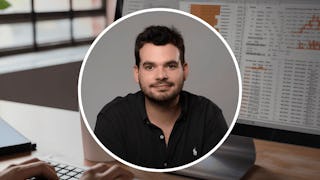Welcome to the exciting world of data analysis and unlock its power in today's dynamic business landscape. This course offers a comprehensive guide to mastering data analysis, transforming it into more than just a valuable skill. Gain essential knowledge and tools to convert data into actionable insights, drive informed decisions, and fuel business growth.

Gain next-level skills with Coursera Plus for $199 (regularly $399). Save now.

(22 reviews)
Recommended experience
What you'll learn
Uncover patterns/trends in data using data visualization, summary statistics, confidence intervals & hypothesis testing to make informed decisions
Develop the ability to model and analyze the relationships between variables using linear and multiple regression models
Acquire expertise in various statistical tests such as t-tests, chi-square tests, and ANOVA to compare groups and determine significant differences
Learn to interpret the results of data analysis, draw meaningful conclusions, and make data-driven recommendations
Skills you'll gain
Details to know

Add to your LinkedIn profile
16 assignments
See how employees at top companies are mastering in-demand skills

There are 6 modules in this course
Managerial decision-making is complicated, especially given the fast-paced and ever-changing business landscape. This necessitates that management graduates possess the skills to effectively navigate real-world challenges and employ robust analytical thinking. Such proficiency entails processing data, recognizing assumptions, addressing biases, and confidently making managerial judgments. This course will delve into utilization of MS Excel, demonstrating its applications through real-world case studies. Covering fundamental topics such as descriptive statistics, probability, sampling techniques, hypothesis testing, ANOVA, and basics of regression, the course aims to empower individuals to make informed, data-driven decisions and effectively communicate their findings. We begin the journey as we delve into the essentials of statistics, data types, and scales. You'll learn how to compute and interpret statistical measures in Descriptive Statistics and understand fundamental Probability laws, Bayes' theorem, and business applications.
What's included
11 videos11 readings4 assignments
This week, we continue with the fundamentals of probability, we introduce the concepts of random variables and probability distribution - namely - discrete and continuous. The focus for this course will be on Normal distribution. You will also learn the different types of Samples - Sample selection process and estimation of population mean using sample statistics. Further, you will get an understanding of how Sampling distribution. provides valuable insights into the variability that can be expected by repeatedly drawing samples from the same population.
What's included
7 videos4 readings2 assignments
The Business Statistics module concludes with a discussion on the margin of error and its relation to sample estimates. You'll learn to calculate interval estimates and apply them in business contexts. Additionally, this week we will cover hypothesis testing, which includes formulating null and alternate hypotheses and conducting significance tests to determine criteria for hypothesis rejection. We will further explore the implications of type I and type II errors in this decision-making.
What's included
7 videos3 readings3 assignments
This week we explore statistical inferences involving multiple populations, with a particular emphasis on ANOVA as a method for comparing means among multiple groups or populations. You'll understand ANOVA's significance in assessing group differences and gain insights into interpreting the produced F-statistic. ANOVA facilitates identifying significant differences between group means and comprehending sources of data variation.
What's included
6 videos4 readings2 assignments
This week we introduce Regression Analysis as we delve into the relationship between dependent and independent variables. You'll discover how Regression analysis estimates the dependent variable values based on known independent variables, aiding in identifying the best-fit line or curve representing data patterns and trends. This analysis facilitates uncovering insights crucial for informed decision-making across various fields.
What's included
7 videos5 readings2 assignments
The course wraps up with a unique twist: testing the association of two variables in a contingency table; testing if a variable is likely to come from a particular distribution. We will delve into concepts such as contingency tables, column and row percentages, observed and expected frequencies, and apply Chi-square statistics to test population proportion equality. Additionally, we will learn how to use Chi-square statistics to test the independence of two categorical variables and assess goodness of fit to determine if an observed dataset aligns with a specific distribution.
What's included
2 videos3 readings3 assignments
Build toward a degree
This course is part of the following degree program(s) offered by S.P. Jain Institute of Management and Research. If you are admitted and enroll, your completed coursework may count toward your degree learning and your progress can transfer with you.¹
Instructor

Explore more from Data Analysis
 Status: Free Trial
Status: Free TrialUniversity of Colorado Boulder
 Status: Free Trial
Status: Free Trial Status: Free Trial
Status: Free TrialCertNexus
 Status: Free Trial
Status: Free TrialQueen Mary University of London
Why people choose Coursera for their career




Frequently asked questions
To access the course materials, assignments and to earn a Certificate, you will need to purchase the Certificate experience when you enroll in a course. You can try a Free Trial instead, or apply for Financial Aid. The course may offer 'Full Course, No Certificate' instead. This option lets you see all course materials, submit required assessments, and get a final grade. This also means that you will not be able to purchase a Certificate experience.
When you purchase a Certificate you get access to all course materials, including graded assignments. Upon completing the course, your electronic Certificate will be added to your Accomplishments page - from there, you can print your Certificate or add it to your LinkedIn profile.
Yes. In select learning programs, you can apply for financial aid or a scholarship if you can’t afford the enrollment fee. If fin aid or scholarship is available for your learning program selection, you’ll find a link to apply on the description page.
More questions
Financial aid available,





